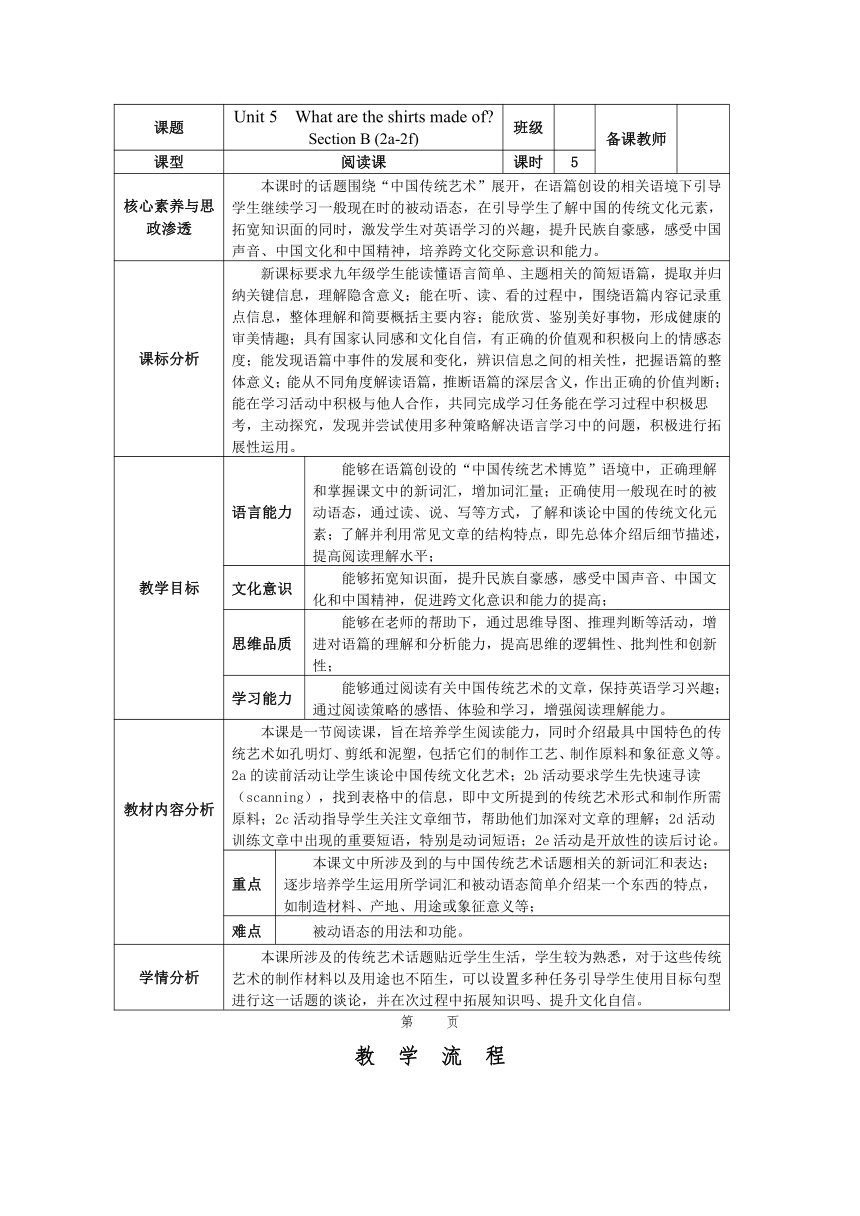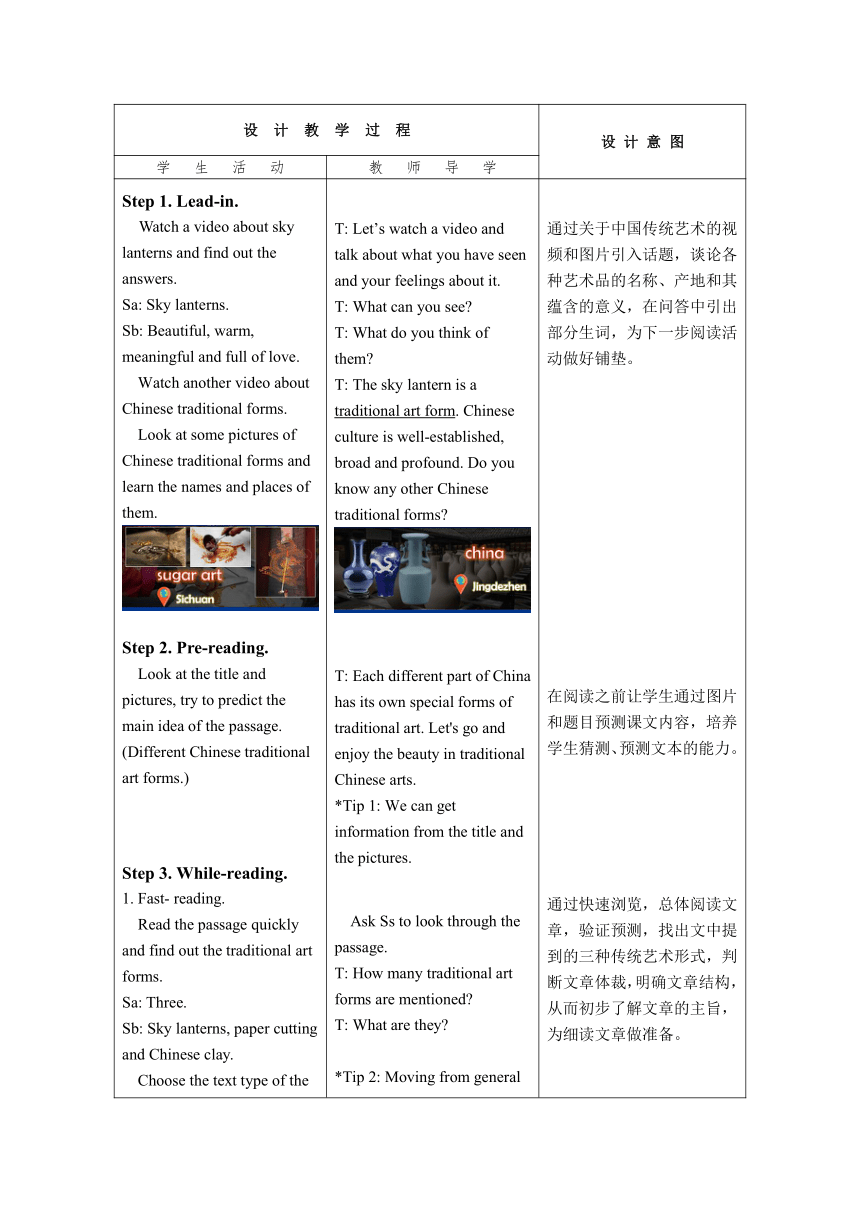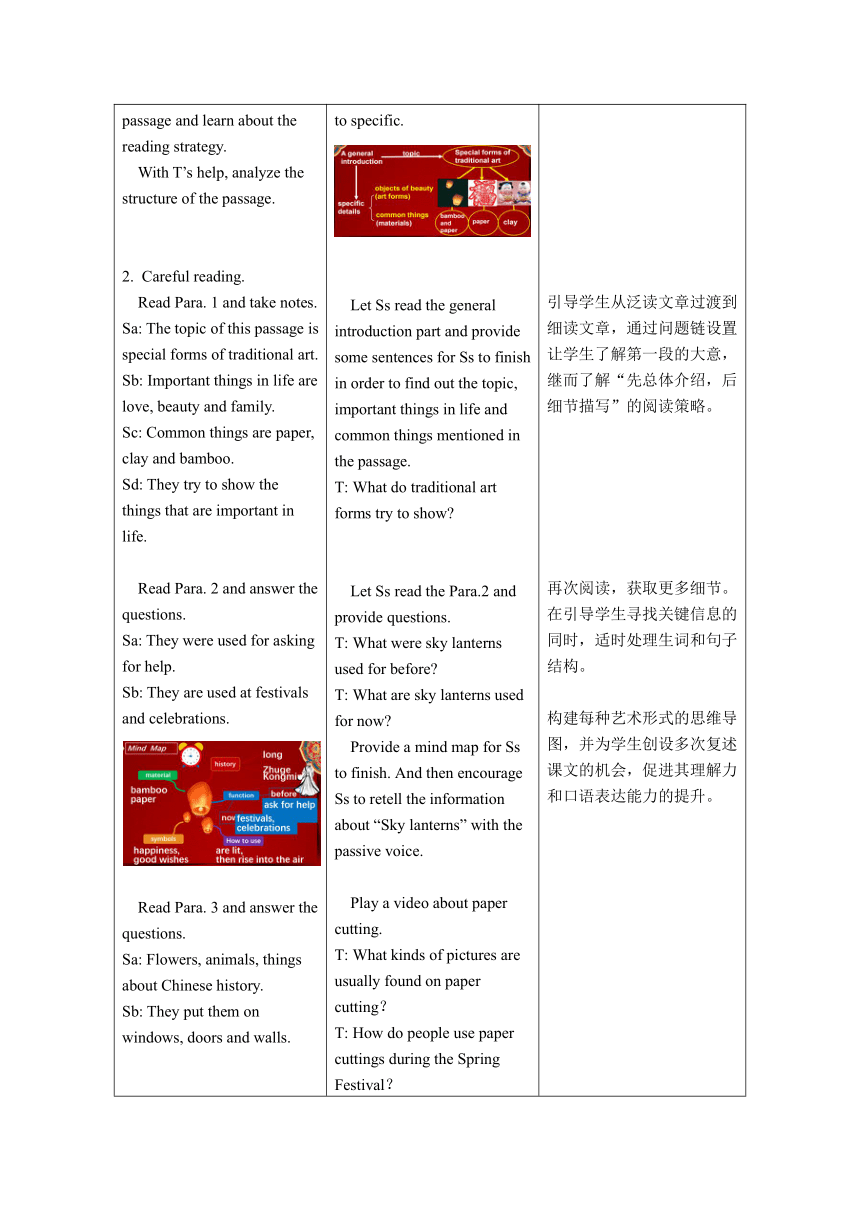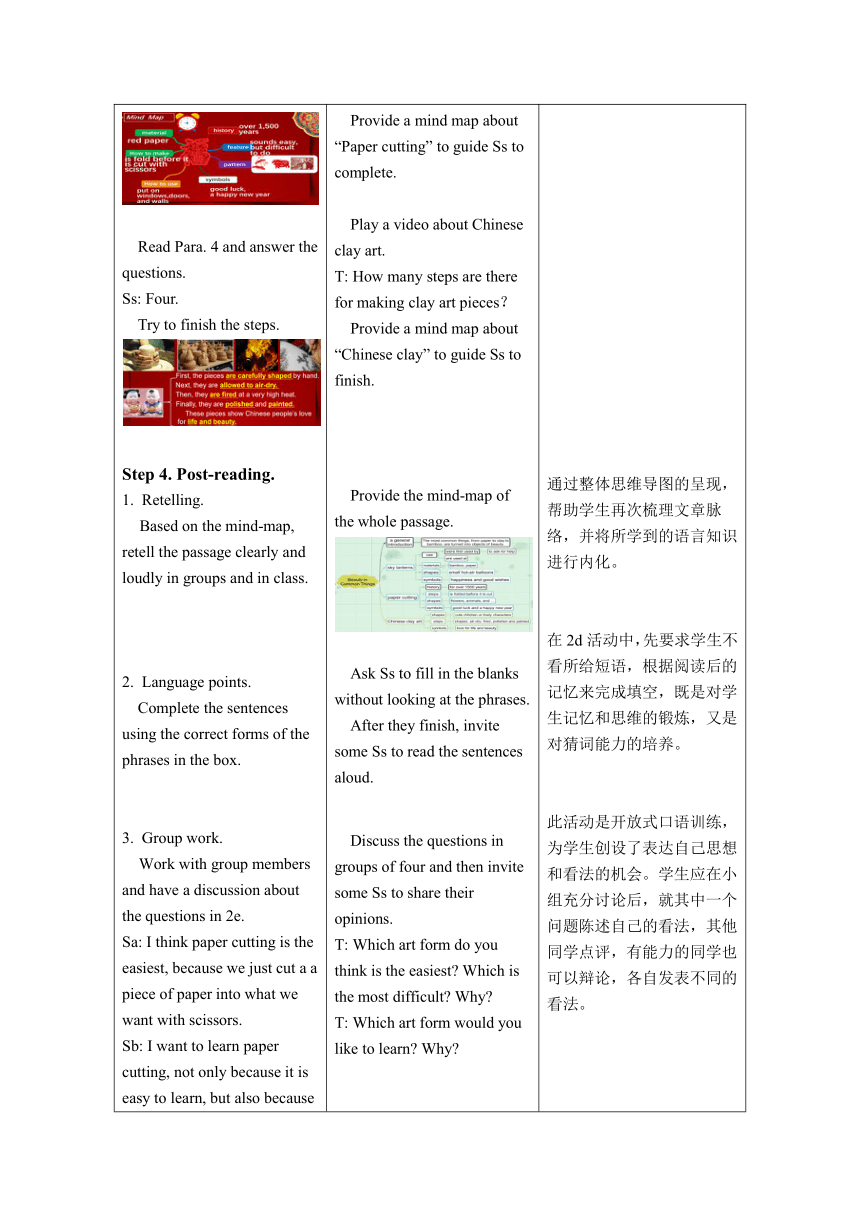Unit 5 What are the shirts made of? Section B (2a-2f) 五课时教学设计(大阅读)(表格式)
文档属性
| 名称 | Unit 5 What are the shirts made of? Section B (2a-2f) 五课时教学设计(大阅读)(表格式) |  | |
| 格式 | docx | ||
| 文件大小 | 941.9KB | ||
| 资源类型 | 教案 | ||
| 版本资源 | 人教新目标(Go for it)版 | ||
| 科目 | 英语 | ||
| 更新时间 | 2024-09-24 09:58:03 | ||
图片预览




文档简介
课题 Unit 5 What are the shirts made of Section B (2a-2f) 班级 备课教师
课型 阅读课 课时 5
核心素养与思政渗透 本课时的话题围绕“中国传统艺术”展开,在语篇创设的相关语境下引导学生继续学习一般现在时的被动语态,在引导学生了解中国的传统文化元素,拓宽知识面的同时,激发学生对英语学习的兴趣,提升民族自豪感,感受中国声音、中国文化和中国精神,培养跨文化交际意识和能力。
课标分析 新课标要求九年级学生能读懂语言简单、主题相关的简短语篇,提取并归纳关键信息,理解隐含意义;能在听、读、看的过程中,围绕语篇内容记录重点信息,整体理解和简要概括主要内容;能欣赏、鉴别美好事物,形成健康的审美情趣;具有国家认同感和文化自信,有正确的价值观和积极向上的情感态度;能发现语篇中事件的发展和变化,辨识信息之间的相关性,把握语篇的整体意义;能从不同角度解读语篇,推断语篇的深层含义,作出正确的价值判断;能在学习活动中积极与他人合作,共同完成学习任务能在学习过程中积极思考,主动探究,发现并尝试使用多种策略解决语言学习中的问题,积极进行拓展性运用。
教学目标 语言能力 能够在语篇创设的“中国传统艺术博览”语境中,正确理解和掌握课文中的新词汇,增加词汇量;正确使用一般现在时的被动语态,通过读、说、写等方式,了解和谈论中国的传统文化元素;了解并利用常见文章的结构特点,即先总体介绍后细节描述,提高阅读理解水平;
文化意识 能够拓宽知识面,提升民族自豪感,感受中国声音、中国文化和中国精神,促进跨文化意识和能力的提高;
思维品质 能够在老师的帮助下,通过思维导图、推理判断等活动,增进对语篇的理解和分析能力,提高思维的逻辑性、批判性和创新性;
学习能力 能够通过阅读有关中国传统艺术的文章,保持英语学习兴趣;通过阅读策略的感悟、体验和学习,增强阅读理解能力。
教材内容分析 本课是一节阅读课,旨在培养学生阅读能力,同时介绍最具中国特色的传统艺术如孔明灯、剪纸和泥塑,包括它们的制作工艺、制作原料和象征意义等。2a的读前活动让学生谈论中国传统文化艺术;2b活动要求学生先快速寻读(scanning),找到表格中的信息,即中文所提到的传统艺术形式和制作所需原料;2c活动指导学生关注文章细节,帮助他们加深对文章的理解;2d活动训练文章中出现的重要短语,特别是动词短语;2e活动是开放性的读后讨论。
重点 本课文中所涉及到的与中国传统艺术话题相关的新词汇和表达;逐步培养学生运用所学词汇和被动语态简单介绍某一个东西的特点,如制造材料、产地、用途或象征意义等;
难点 被动语态的用法和功能。
学情分析 本课所涉及的传统艺术话题贴近学生生活,学生较为熟悉,对于这些传统艺术的制作材料以及用途也不陌生,可以设置多种任务引导学生使用目标句型进行这一话题的谈论,并在次过程中拓展知识吗、提升文化自信。
第 页
教 学 流 程
设 计 教 学 过 程 设 计 意 图
学 生 活 动 教 师 导 学
Step 1. Lead-in. Watch a video about sky lanterns and find out the answers. Sa: Sky lanterns. Sb: Beautiful, warm, meaningful and full of love. Watch another video about Chinese traditional forms. Look at some pictures of Chinese traditional forms and learn the names and places of them. Step 2. Pre-reading. Look at the title and pictures, try to predict the main idea of the passage. (Different Chinese traditional art forms.) Step 3. While-reading. 1. Fast- reading. Read the passage quickly and find out the traditional art forms. Sa: Three. Sb: Sky lanterns, paper cutting and Chinese clay. Choose the text type of the passage and learn about the reading strategy. With T’s help, analyze the structure of the passage. Careful reading. Read Para. 1 and take notes. Sa: The topic of this passage is special forms of traditional art. Sb: Important things in life are love, beauty and family. Sc: Common things are paper, clay and bamboo. Sd: They try to show the things that are important in life. Read Para. 2 and answer the questions. Sa: They were used for asking for help. Sb: They are used at festivals and celebrations. Read Para. 3 and answer the questions. Sa: Flowers, animals, things about Chinese history. Sb: They put them on windows, doors and walls. Read Para. 4 and answer the questions. Ss: Four. Try to finish the steps. Step 4. Post-reading. Retelling. Based on the mind-map, retell the passage clearly and loudly in groups and in class. Language plete the sentences using the correct forms of the phrases in the box. Group work. Work with group members and have a discussion about the questions in 2e. Sa: I think paper cutting is the easiest, because we just cut a a piece of paper into what we want with scissors. Sb: I want to learn paper cutting, not only because it is easy to learn, but also because we can do it at any time. Step 5. Summary. Watch a video about Chinese culture. Try to think about T’s questions and have a free talk. T: Let’s watch a video and talk about what you have seen and your feelings about it. T: What can you see T: What do you think of them T: The sky lantern is a traditional art form. Chinese culture is well-established, broad and profound. Do you know any other Chinese traditional forms T: Each different part of China has its own special forms of traditional art. Let's go and enjoy the beauty in traditional Chinese arts. *Tip 1: We can get information from the title and the pictures. Ask Ss to look through the passage. T: How many traditional art forms are mentioned T: What are they *Tip 2: Moving from general to specific. Let Ss read the general introduction part and provide some sentences for Ss to finish in order to find out the topic, important things in life and common things mentioned in the passage. T: What do traditional art forms try to show Let Ss read the Para.2 and provide questions. T: What were sky lanterns used for before T: What are sky lanterns used for now Provide a mind map for Ss to finish. And then encourage Ss to retell the information about “Sky lanterns” with the passive voice. Play a video about paper cutting. T: What kinds of pictures are usually found on paper cutting? T: How do people use paper cuttings during the Spring Festival? Provide a mind map about “Paper cutting” to guide Ss to complete. Play a video about Chinese clay art. T: How many steps are there for making clay art pieces? Provide a mind map about “Chinese clay” to guide Ss to finish. Provide the mind-map of the whole passage. Ask Ss to fill in the blanks without looking at the phrases. After they finish, invite some Ss to read the sentences aloud. Discuss the questions in groups of four and then invite some Ss to share their opinions. T: Which art form do you think is the easiest Which is the most difficult Why T: Which art form would you like to learn Why T: Common things are turned into objects of beauty.What creates beauty 通过关于中国传统艺术的视频和图片引入话题,谈论各种艺术品的名称、产地和其蕴含的意义,在问答中引出部分生词,为下一步阅读活动做好铺垫。 在阅读之前让学生通过图片和题目预测课文内容,培养学生猜测、预测文本的能力。 通过快速浏览,总体阅读文章,验证预测,找出文中提到的三种传统艺术形式,判断文章体裁,明确文章结构,从而初步了解文章的主旨,为细读文章做准备。 引导学生从泛读文章过渡到细读文章,通过问题链设置让学生了解第一段的大意,继而了解“先总体介绍,后细节描写”的阅读策略。 再次阅读,获取更多细节。在引导学生寻找关键信息的同时,适时处理生词和句子结构。 构建每种艺术形式的思维导图,并为学生创设多次复述课文的机会,促进其理解力和口语表达能力的提升。 通过整体思维导图的呈现,帮助学生再次梳理文章脉络,并将所学到的语言知识进行内化。 在2d活动中,先要求学生不看所给短语,根据阅读后的记忆来完成填空,既是对学生记忆和思维的锻炼,又是对猜词能力的培养。 此活动是开放式口语训练,为学生创设了表达自己思想和看法的机会。学生应在小组充分讨论后,就其中一个问题陈述自己的看法,其他同学点评,有能力的同学也可以辩论,各自发表不同的看法。 进行情感渗透,使学生在感受中国声音、中国文化和中国精神中,提升民族自豪感,增强文化自信。
第 页
课 时 达 标 检 测
Ⅰ. 选词填空。 after as before centre common complete connect express history lively these this
Each different part of China has its own special forms of traditional art. Chinese paper cutting, or jianzhi, is a kind of folk art. It's a way to 1. people's hope and feelings.It has a 2. of more than 1,500 years.Paper cutting sounds very easy but it can be difficult.Red paper is usually used as red is 3. with happiness in Chinese culture.The most 4. pictures are flowers,animals,xi(喜)and fu(福).They are put on windows,doors, and walls 5. symbols of wishes for good luck. Chinese clay art is well known and popular all over the country.Now many kids learn to make it in schools or even shopping 6. .To make Chinese clay art,the clay is shaped by hand into things,such as cute children or 7. characters from a Chinese fairy tale or historical story.8. the things get dry in the air,they are fired at a very high heat and then polished and painted.It takes several weeks to 9. everything.Although they look so small,they look very real.10. small pieces of clay art show the love that all Chinese people have for life and beauty. Ⅱ.阅读理解。 Every school day,we use schoolbags to carry all of our things to school.They are a big part of our lives.But have you ever thought about the history of the schoolbag? In the Han Dynasty(汉朝),students in old﹣style private schools used bamboo boxes to carry books to school.People consider the bamboo boxes to be the earliest schoolbags.There were usually two or three layers(层) in the box.Kids put different things like books,brushes,ink stones(砚) and paper in the boxes. Hundreds of years later,people developed a new kind of schoolbag called budai,or the "hip﹣pocket".Budai was lighter than the bamboo box.With the founding(成立) of the People's Republic of China,military rucksacks(军用帆布包) became popular.Many people carried them when they were in school.Ask your grandparents or parents about these bags.Maybe they can tell you about their experiences of carrying them when they were in school. A new style of schoolbags has appeared in recent years.Many of them have colorful and fashionable designs(时尚的设计) on them,such as pictures of cartoons or pop stars.And they are more comfortable to use.Some students pull wheeled bags filled with heavy textbooks and others carry backpacks. Schoolbags are still changing.Can you imagine what future schoolbags will be like? ( )11. Schoolbags in the Han Dynasty were made of . A.cloth B.paper C.plastic D.bamboo ( )12. Which is NOT true according to the passage? A.Military rucksacks were popular in the 1950s. B.Budai was heavier than the bamboo box. C.There are some pictures on the new style of schoolbags. D.Schoolbags have changed a lot. ( )13. To carry heavy textbooks,students would like to use . A.wheeled bags B.military rucksacks C.bamboo boxes D.budai ( )14. We may read the article in a . A.letter B.guidebook C.newspaper D.notice ( )15. The purpose of the article is . A.to tell us how to use schoolbags B.to explain why we use schoolbags C.to introduce the importance of schoolbags D.to introduce the development of schoolbags
第 页
课 时 教 学 设 计 尾 页
板 书 设 计
Unit 5 What are the shirts made of Section B (2a-2f)
作 业 设 计
Level A Write a passage about another traditional art form: Wei Fang Kites Directions: 1. Introduce the art form. 2. Describe the materials used to make it. 3. Explain when and how people use it. 4. Write about its special features(特征). 5. Explain what it symbolizes.
Level B Retell the whole passage to your partner with the help of a mind map.
教 学 反 思
第 页
课型 阅读课 课时 5
核心素养与思政渗透 本课时的话题围绕“中国传统艺术”展开,在语篇创设的相关语境下引导学生继续学习一般现在时的被动语态,在引导学生了解中国的传统文化元素,拓宽知识面的同时,激发学生对英语学习的兴趣,提升民族自豪感,感受中国声音、中国文化和中国精神,培养跨文化交际意识和能力。
课标分析 新课标要求九年级学生能读懂语言简单、主题相关的简短语篇,提取并归纳关键信息,理解隐含意义;能在听、读、看的过程中,围绕语篇内容记录重点信息,整体理解和简要概括主要内容;能欣赏、鉴别美好事物,形成健康的审美情趣;具有国家认同感和文化自信,有正确的价值观和积极向上的情感态度;能发现语篇中事件的发展和变化,辨识信息之间的相关性,把握语篇的整体意义;能从不同角度解读语篇,推断语篇的深层含义,作出正确的价值判断;能在学习活动中积极与他人合作,共同完成学习任务能在学习过程中积极思考,主动探究,发现并尝试使用多种策略解决语言学习中的问题,积极进行拓展性运用。
教学目标 语言能力 能够在语篇创设的“中国传统艺术博览”语境中,正确理解和掌握课文中的新词汇,增加词汇量;正确使用一般现在时的被动语态,通过读、说、写等方式,了解和谈论中国的传统文化元素;了解并利用常见文章的结构特点,即先总体介绍后细节描述,提高阅读理解水平;
文化意识 能够拓宽知识面,提升民族自豪感,感受中国声音、中国文化和中国精神,促进跨文化意识和能力的提高;
思维品质 能够在老师的帮助下,通过思维导图、推理判断等活动,增进对语篇的理解和分析能力,提高思维的逻辑性、批判性和创新性;
学习能力 能够通过阅读有关中国传统艺术的文章,保持英语学习兴趣;通过阅读策略的感悟、体验和学习,增强阅读理解能力。
教材内容分析 本课是一节阅读课,旨在培养学生阅读能力,同时介绍最具中国特色的传统艺术如孔明灯、剪纸和泥塑,包括它们的制作工艺、制作原料和象征意义等。2a的读前活动让学生谈论中国传统文化艺术;2b活动要求学生先快速寻读(scanning),找到表格中的信息,即中文所提到的传统艺术形式和制作所需原料;2c活动指导学生关注文章细节,帮助他们加深对文章的理解;2d活动训练文章中出现的重要短语,特别是动词短语;2e活动是开放性的读后讨论。
重点 本课文中所涉及到的与中国传统艺术话题相关的新词汇和表达;逐步培养学生运用所学词汇和被动语态简单介绍某一个东西的特点,如制造材料、产地、用途或象征意义等;
难点 被动语态的用法和功能。
学情分析 本课所涉及的传统艺术话题贴近学生生活,学生较为熟悉,对于这些传统艺术的制作材料以及用途也不陌生,可以设置多种任务引导学生使用目标句型进行这一话题的谈论,并在次过程中拓展知识吗、提升文化自信。
第 页
教 学 流 程
设 计 教 学 过 程 设 计 意 图
学 生 活 动 教 师 导 学
Step 1. Lead-in. Watch a video about sky lanterns and find out the answers. Sa: Sky lanterns. Sb: Beautiful, warm, meaningful and full of love. Watch another video about Chinese traditional forms. Look at some pictures of Chinese traditional forms and learn the names and places of them. Step 2. Pre-reading. Look at the title and pictures, try to predict the main idea of the passage. (Different Chinese traditional art forms.) Step 3. While-reading. 1. Fast- reading. Read the passage quickly and find out the traditional art forms. Sa: Three. Sb: Sky lanterns, paper cutting and Chinese clay. Choose the text type of the passage and learn about the reading strategy. With T’s help, analyze the structure of the passage. Careful reading. Read Para. 1 and take notes. Sa: The topic of this passage is special forms of traditional art. Sb: Important things in life are love, beauty and family. Sc: Common things are paper, clay and bamboo. Sd: They try to show the things that are important in life. Read Para. 2 and answer the questions. Sa: They were used for asking for help. Sb: They are used at festivals and celebrations. Read Para. 3 and answer the questions. Sa: Flowers, animals, things about Chinese history. Sb: They put them on windows, doors and walls. Read Para. 4 and answer the questions. Ss: Four. Try to finish the steps. Step 4. Post-reading. Retelling. Based on the mind-map, retell the passage clearly and loudly in groups and in class. Language plete the sentences using the correct forms of the phrases in the box. Group work. Work with group members and have a discussion about the questions in 2e. Sa: I think paper cutting is the easiest, because we just cut a a piece of paper into what we want with scissors. Sb: I want to learn paper cutting, not only because it is easy to learn, but also because we can do it at any time. Step 5. Summary. Watch a video about Chinese culture. Try to think about T’s questions and have a free talk. T: Let’s watch a video and talk about what you have seen and your feelings about it. T: What can you see T: What do you think of them T: The sky lantern is a traditional art form. Chinese culture is well-established, broad and profound. Do you know any other Chinese traditional forms T: Each different part of China has its own special forms of traditional art. Let's go and enjoy the beauty in traditional Chinese arts. *Tip 1: We can get information from the title and the pictures. Ask Ss to look through the passage. T: How many traditional art forms are mentioned T: What are they *Tip 2: Moving from general to specific. Let Ss read the general introduction part and provide some sentences for Ss to finish in order to find out the topic, important things in life and common things mentioned in the passage. T: What do traditional art forms try to show Let Ss read the Para.2 and provide questions. T: What were sky lanterns used for before T: What are sky lanterns used for now Provide a mind map for Ss to finish. And then encourage Ss to retell the information about “Sky lanterns” with the passive voice. Play a video about paper cutting. T: What kinds of pictures are usually found on paper cutting? T: How do people use paper cuttings during the Spring Festival? Provide a mind map about “Paper cutting” to guide Ss to complete. Play a video about Chinese clay art. T: How many steps are there for making clay art pieces? Provide a mind map about “Chinese clay” to guide Ss to finish. Provide the mind-map of the whole passage. Ask Ss to fill in the blanks without looking at the phrases. After they finish, invite some Ss to read the sentences aloud. Discuss the questions in groups of four and then invite some Ss to share their opinions. T: Which art form do you think is the easiest Which is the most difficult Why T: Which art form would you like to learn Why T: Common things are turned into objects of beauty.What creates beauty 通过关于中国传统艺术的视频和图片引入话题,谈论各种艺术品的名称、产地和其蕴含的意义,在问答中引出部分生词,为下一步阅读活动做好铺垫。 在阅读之前让学生通过图片和题目预测课文内容,培养学生猜测、预测文本的能力。 通过快速浏览,总体阅读文章,验证预测,找出文中提到的三种传统艺术形式,判断文章体裁,明确文章结构,从而初步了解文章的主旨,为细读文章做准备。 引导学生从泛读文章过渡到细读文章,通过问题链设置让学生了解第一段的大意,继而了解“先总体介绍,后细节描写”的阅读策略。 再次阅读,获取更多细节。在引导学生寻找关键信息的同时,适时处理生词和句子结构。 构建每种艺术形式的思维导图,并为学生创设多次复述课文的机会,促进其理解力和口语表达能力的提升。 通过整体思维导图的呈现,帮助学生再次梳理文章脉络,并将所学到的语言知识进行内化。 在2d活动中,先要求学生不看所给短语,根据阅读后的记忆来完成填空,既是对学生记忆和思维的锻炼,又是对猜词能力的培养。 此活动是开放式口语训练,为学生创设了表达自己思想和看法的机会。学生应在小组充分讨论后,就其中一个问题陈述自己的看法,其他同学点评,有能力的同学也可以辩论,各自发表不同的看法。 进行情感渗透,使学生在感受中国声音、中国文化和中国精神中,提升民族自豪感,增强文化自信。
第 页
课 时 达 标 检 测
Ⅰ. 选词填空。 after as before centre common complete connect express history lively these this
Each different part of China has its own special forms of traditional art. Chinese paper cutting, or jianzhi, is a kind of folk art. It's a way to 1. people's hope and feelings.It has a 2. of more than 1,500 years.Paper cutting sounds very easy but it can be difficult.Red paper is usually used as red is 3. with happiness in Chinese culture.The most 4. pictures are flowers,animals,xi(喜)and fu(福).They are put on windows,doors, and walls 5. symbols of wishes for good luck. Chinese clay art is well known and popular all over the country.Now many kids learn to make it in schools or even shopping 6. .To make Chinese clay art,the clay is shaped by hand into things,such as cute children or 7. characters from a Chinese fairy tale or historical story.8. the things get dry in the air,they are fired at a very high heat and then polished and painted.It takes several weeks to 9. everything.Although they look so small,they look very real.10. small pieces of clay art show the love that all Chinese people have for life and beauty. Ⅱ.阅读理解。 Every school day,we use schoolbags to carry all of our things to school.They are a big part of our lives.But have you ever thought about the history of the schoolbag? In the Han Dynasty(汉朝),students in old﹣style private schools used bamboo boxes to carry books to school.People consider the bamboo boxes to be the earliest schoolbags.There were usually two or three layers(层) in the box.Kids put different things like books,brushes,ink stones(砚) and paper in the boxes. Hundreds of years later,people developed a new kind of schoolbag called budai,or the "hip﹣pocket".Budai was lighter than the bamboo box.With the founding(成立) of the People's Republic of China,military rucksacks(军用帆布包) became popular.Many people carried them when they were in school.Ask your grandparents or parents about these bags.Maybe they can tell you about their experiences of carrying them when they were in school. A new style of schoolbags has appeared in recent years.Many of them have colorful and fashionable designs(时尚的设计) on them,such as pictures of cartoons or pop stars.And they are more comfortable to use.Some students pull wheeled bags filled with heavy textbooks and others carry backpacks. Schoolbags are still changing.Can you imagine what future schoolbags will be like? ( )11. Schoolbags in the Han Dynasty were made of . A.cloth B.paper C.plastic D.bamboo ( )12. Which is NOT true according to the passage? A.Military rucksacks were popular in the 1950s. B.Budai was heavier than the bamboo box. C.There are some pictures on the new style of schoolbags. D.Schoolbags have changed a lot. ( )13. To carry heavy textbooks,students would like to use . A.wheeled bags B.military rucksacks C.bamboo boxes D.budai ( )14. We may read the article in a . A.letter B.guidebook C.newspaper D.notice ( )15. The purpose of the article is . A.to tell us how to use schoolbags B.to explain why we use schoolbags C.to introduce the importance of schoolbags D.to introduce the development of schoolbags
第 页
课 时 教 学 设 计 尾 页
板 书 设 计
Unit 5 What are the shirts made of Section B (2a-2f)
作 业 设 计
Level A Write a passage about another traditional art form: Wei Fang Kites Directions: 1. Introduce the art form. 2. Describe the materials used to make it. 3. Explain when and how people use it. 4. Write about its special features(特征). 5. Explain what it symbolizes.
Level B Retell the whole passage to your partner with the help of a mind map.
教 学 反 思
第 页
同课章节目录
- Unit 1 How can we become good learners.
- Section A
- Section B
- Unit 2 I think that mooncakes are delicious!
- Section A
- Section B
- Unit 3 Could you please tell me where the restroom
- Section A
- Section B
- Unit 4 I used to be afraid of the dark.
- Section A
- Section B
- Unit 5 What are the shirts made of?
- Section A
- Section B
- Review of Units 1-5
- Unit 6 When was it invented?
- Section A
- Section B
- Unit 7 Teenagers should be allowed to choose their
- Section A
- Section B
- Unit 8 It must belong to Carla.
- Section A
- Section B
- Unit 9 I like music that I can dance to.
- Section A
- Section B
- Unit 10 You're supposed to shake hands.
- Section A
- Section B
- Review of Units 6-10
- Unit 11 Sad movies make me cry.
- Section A
- Section B
- Unit 12 Life is full of the unexpected
- Section A
- Section B
- Unit 13 We're trying to save the earth!
- Section A
- Section B
- Unit 14 I remember meeting all of you in Grade 7.
- Section A
- Section B
- Review of Units 11-14
